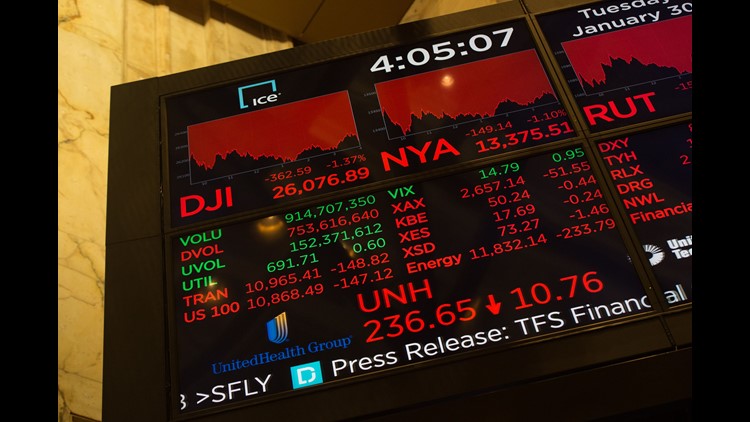The Dow tumbled 666 points Friday — its sixth-biggest point loss ever — and suffered its worst week in two years as investors turned skittish about interest rates, dashing much of the optimism that had been powering stocks to record highs.
In a matter of days, the mood of investors has swung from euphoria to real concern that the stock market, which as recently as last week was hitting new highs, might be at the start of its first sizable decline in years. The market, which is down about 4% from its recent peak, hasn't suffered a 10% drop since February 2016.
The blue-chip Dow suffered its worst point decline since the financial crisis in October 2008.
While the point gain might seem big and cause major anxiety for investors, the Dow's percentage drop of 2.5% Friday didn't even come close to a top-20 percentage drop for the popular stock gauge.
On Black Monday, for example, during the stock market crash of Oct. 19, 1987, the Dow dropped 22.6%, which back then amounted to 508 points.
Ironically, Friday's selloff was sparked by continued good news in the jobs market, with the government reporting that the economy created 200,000 jobs in January, and data showing wages for U.S. workers jumped nearly 3% in the past year, spurring fears of a coming spike in inflation.
Good news for workers, however, is viewed as not-so-good news for stocks as it suggests the economy is in danger of overheating, which could pressure the Federal Reserve to hike short-term interest rates more aggressively than expected, says Russell Price, senior economist at Ameriprise Financial.
"Temporarily, good news may be bad news for the stock market," he says.
The big change in the market mentality is the fear that borrowing rates, which have been near record lows since the financial crisis and were a catalyst behind the current bull market for stocks, might be on the verge of moving dramatically higher.
"The major driver of the selloff is the awakening to the new interest rate environment," said Erik Davidson, chief investment officer at Wells Fargo Private Bank.
A big selloff in the U.S. government bond market sent the yield on the 10-year Treasury up above 2.85%, its highest level since January 2014.
Higher rates mean higher borrowing costs for consumers and businesses, which can slow economic growth.
Despite the steep Dow drop, now is not the time for investors to get spooked out of the market, says Kate Warne, chief market strategist at Edward Jones, a Wall Street financial firm.
Investors must take the bad week in stride, as the economy remains strong and corporate earnings are expected to benefit this year from corporate tax cuts.
"It's not time to panic," Warne says, noting that the broad Standard & Poor's 500 stock index is down just 3.9% from its Jan. 26 record high.
The market has experienced one of its longest periods of relative calm on record. Prior to today's selloff, it had gone 448 days without suffering a drop of 3% or more, the longest run on record.
And it hasn't suffered a 5% drop since the June 2016 -- the second-longest streak without a so-called "pullback" in history.
"Pullbacks normally occur about three times a year," says Warne.
Stocks also seemed to be dragged down by the Republicans' release of a controversial and now-declassified memo alleging that the FBI and Department of Justice abused their surveillance authority to target his 2016 presidential campaign.



